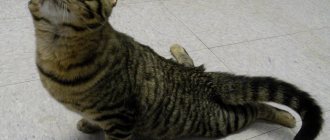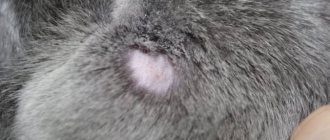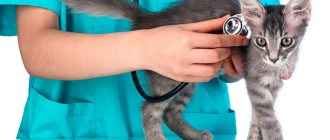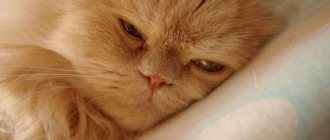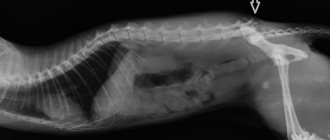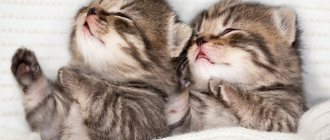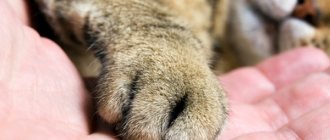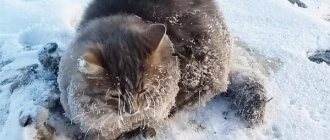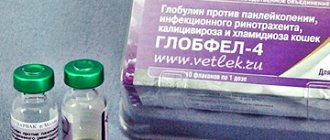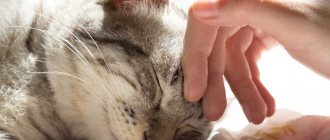6009Pavel
Those who have lived with cats for a long time note that many pets often experience a strange and unpleasant situation. Suddenly the animal sits down on its hind legs, begins to pull them, and thus constantly moves around the house. We’ll help you figure out what the problem is when a cat pulls its hind legs and how to help your pet cope with it.
Speaking from a theoretical point of view, stretching of the hind legs in cats can be directly associated with a number of disorders in the functioning of the limbs. In some cases, paws may be removed due to unsuccessful exposure to the external environment. For example, when a cat makes an incorrect and hard landing on its hind legs.
© shutterstock
But this is far from the only reason. Thus, problems of internal organs can also cause limited ability to work in the lower extremities.
It is worth noting that with this disorder, the cat refuses to be stroked on the back and reacts aggressively to any touch to the lower part of the spine.
Reasons for violation
If a mustachioed tabby stretches its hind legs, meows pitifully and reacts aggressively to attempts to stroke its back, then you can suspect:
- Injury to the lumbar spine or limbs due to an unsuccessful landing, a car collision, or a dog attack.
- Intervertebral hernia - infringement can lead to paralysis or decreased tone of the muscles of the hind limbs if the hernia is localized in the lumbar spine.
- Thromboembolism of the femoral artery - an embolus (blood clot, air bubble, parasite) clogs the vessel, disrupts tissue nutrition and leads to decreased sensitivity, impaired motor function, and pain.
- Pinched sciatic nerve - veterinarians claim that this pathology is quite common in their practice. Moreover, the pathology affects primarily the function of the hind limbs, while appetite, temperature and other characteristics of the condition remain normal.
- Cardiomyopathy, problems with the heart muscle.
- Diseases of the internal organs - often the cat pulls its paws due to urolithiasis, obstruction of the ureters, or inflammation of the kidneys.
- Paralysis – the cause may be neuroinfection, intoxication, viral diseases, worms. In addition to the immobility of the hind legs, other symptoms will be noted in the anamnesis that indicate the cause of the pathology.
- Purulent endometritis is a dangerous disease due to physiological characteristics that occurs only in cats. The animal not only moves with difficulty, pulls its hind legs, meows loudly in pain, but other symptoms are also noted - bloating, severe thirst, apathy, and frequent urination.
- Tick paralysis - the bite of an infected tick leads to damage to the nervous system, and when the legs fail, treatment is useless.
- Stroke - impaired blood circulation in the tissues can lead to failure of the hind legs.
- Hip dysplasia – this type of pathology is especially common in large breed cats.
- Birth trauma (occurs due to complications during lambing).
- Nutritional hyperparathyroidism - dysfunction of the thyroid gland causes deformation of bones and joints, pain during movement and gait disturbance.
- Age-related changes in the musculoskeletal system.
Breed predisposition. Some breeds are more susceptible than others to pathologies of the musculoskeletal system, muscle weakness, dysplasia and other diseases. The risk group includes the following cat breeds:
- Maine Coon, Chartreuse – hip dysplasia;
- kimrik – congenital weakness of the muscles of the limbs;
- Scottish Folds – osteochondrodysplasia.
Gender dependence. Cats suffer from immunosuppressive mono- and polyarthritis, which causes lameness and impaired limb mobility.
In males, pathologies of the hind limb girdle, joints and bones are 2 times more likely.
Other reasons. Impaired mobility of the hind limbs can be caused by a large number of pathogenic factors.
Power supply errors can cause problems. For example, a lack of thiamine and vitamin D in the diet can lead to dragging of the hind legs, so without professional consultation and diagnostics it is impossible to determine an accurate diagnosis and prescribe treatment.
BEIJINGS forum. PEKINGESE FORUM.: Diseases inherent in the Pekingese breed? — BEIJINGS forum. PEKINGESE FORUM.
Diseases inherent in the Pekingese breed? I want to ask the professionals
When visiting a veterinary clinic with my dog, I often heard from a cardiologist that heart failure is a disease inherent in the Pekingese breed. Due to the short nose and the structure of the spiracle.
Is it so? And what other diseases are inherent in this breed? Is it possible to look at the parents and say that the puppy will not develop a heart disease in the future? Maybe there are some precautionary measures?
Among the Pekingese there are indeed quite a few heart-throbs. Breathing problems are common. Joint diseases are not uncommon: elbow, hip. A predisposition to spinal diseases is quite common. Problems with the eyes are common (increased traumatism, dry keratitis).
However, all these problems are typical not only for Pika, but also for any dog belonging to the group of brachycephalics and chondrodystrophics.
When choosing a puppy, you need to pay attention to the parents, the movements of the dog (the puppy should not limp), the opening of the nostrils (the nostrils should be wide, the air passes freely), the depth of the foot (the bridge of the nose should not be too short, but the muzzle should remain flat), "nose, i.e. With all the charming snubness, there should not be an impression that the bridge of the nose, which is pushed back, is pinching the nasal passages
The dog seemed to stop breathing, her head fell back, she let out one or two screams, and sometimes she had leg cramps. Usually we either breathed into her mouth or grabbed her in our arms, she came to her senses, but after that she was a little lethargic. There was no foam or salivation.
Most likely this is due to pathology of the soft palate. Either anatomical (too long) or neurological (impaired innervation). Such a pity
Source
Symptomatic picture
The cat owner should be alarmed by:
- lameness in one or both legs;
- unsteadiness of gait;
- the cat’s reluctance to jump and run;
- decreased activity;
- restlessness, even to the point of aggressive behavior when trying to touch the hind legs or pelvic area.
Even if one of the listed symptoms is observed, you should consult a specialist.
Why does a cat sleep on a person?
People who cannot imagine life without cats are aware of their pets’ tendency to sleep on their owner or at his feet. There is no need to look for anything mystical in your pet’s behavior if it has long become a habit. But it’s worth thinking about if the cat suddenly changed its inclinations and moved from its favorite place to where it had not previously been noticed. Folk beliefs and signs will help you understand your pet’s atypical behavior.
On the stomach
If a cat lies down on a person’s stomach and kneads it with its paws, it does this for a reason:
- The most common interpretation of signs is health problems. If your pet lies on you and, serenely purring, falls asleep, this is not at all a reason to rush headlong to the doctor. But if your pet has not previously had the habit of trampling your stomach with its paws, it would be a good idea to be examined in a hospital. The fact is that cats’ sense organs are much better developed than those of humans and, perhaps, in this way the animal warns of inflammatory processes that have begun inside your body.
- The following sign applies directly to the female gender. By lying on the girl's stomach and massaging it with her paws, the cat warns the owner about pregnancy. The animal, sensing the birth of a new life, notifies about the good news before the doctors do. In the old days, when medical capabilities were limited, cats were used to determine pregnancy. In anticipation of their first child, the young wife placed her pet on top of her and observed her behavior: if the cat is active, trampling on a place in the abdomen, this means that a new addition is expected in the family.
- For women expecting a child, cat caress can warn of impaired fetal development or the risk of miscarriage. As you know, cats have the ability to heal diseases, and if they knead the belly of a pregnant owner with their paws, they want to help in this way.
Near the head
Often, when a person wakes up in the morning, he finds a furry pet on his pillow. Perhaps the animal spent the night in the owner’s bed for a reason:
- If a cat sleeps on a pillow near the owner's head , this indicates that the person devotes a lot of time and energy to thought processes. Perhaps his profession requires increased attention and concentration. Therefore, the animal, wanting to relieve the tension of the sleeping owner, lies down at the head of the owner’s bed.
- Cats recognize migraines and other headaches. Therefore, even those who are skeptical about conversations about the mystical abilities of animals should not refuse the help of a furry animal.
- Another type of “headache” that cats react to is negative thoughts. They do not give a person peace, which poisons the entire body. A pet, by its presence at the owner’s head, is able to relieve emotional tension and get out of a stressful situation.
Diagnostic methods
The problem is the fact that people go to the veterinary clinic for lameness and gait disturbances in cats much less often than with the same symptoms in dogs.
According to statistics, only 3% of cat owners are consulted at the first signs of pathologies. While dog owners make up 28-30%.
Depending on what diagnosis the doctor makes in advance, he prescribes the first set of studies. Then additional tests may be prescribed to exclude pathologies with similar symptoms (differentiated diagnosis).
Examination methods. The research package may include:
- laboratory tests - blood, urine;
- biochemical studies;
- instrumental - x-ray, MRI, ultrasound.
This minimum complex is often enough to identify the cause of the violations. After the diagnosis is made, the veterinarian develops a treatment regimen and prescribes medications and physical procedures necessary for therapy.
Also watch the video of a cat losing its hind legs:
how to determine when a dog will give birth
Any owner should not only be his pet’s best friend, but if necessary, be able to provide first aid. To do this, you need to know when and how a dog goes into labor. If you have certain knowledge, then this is not difficult to do.
1. If the dog has long hair, then a week before giving birth it needs to be trimmed, especially on the stomach and back, so that the birth is as comfortable as possible.
2. When there is a month left before the birth, it is necessary to equip the place where the dog will give birth with everything necessary. A low box will do; the inside should be soft. In a month, the dog will get used to this place and will not panic and look for a place under the sofa.
Labor can begin prematurely, when it is the dog's first, this is considered normal. Closely monitor your pets from the 56th day of pregnancy; during this time, try not to leave the animal unattended for a long time.
During pregnancy, a bitch has an average body temperature of 38 - 39 `C, and before giving birth there is a drop in temperature to 37 `C. Therefore, if changes in behavior are observed, the animal's temperature should be measured. And if it drops, it means that labor will begin within 32 hours.
The closer the significant event, the more anxious the dog becomes. She looks around different angles, looking for the most suitable place for childbirth.
how to determine when a dog will give birth? if possible by day?? help. if possible by day? Help!
from 60 to 64 days. you will see that her stomach has dropped and she is no longer round like a barrel. just before giving birth, he starts running around the apartment. dig, climb into different corners. sometimes it puffs. nervous - about an hour and a half before giving birth. good luck to you. It varies by day, even for dogs of the same breed, but in general it’s 60-64..
Source
Diagnosis of the disease
If a cat's hind legs have failed, the first step to helping your pet is to consult a veterinarian. In most cases, the specialist prescribes a series of tests. Based on their results, it will already be possible to draw the first conclusions about the causes of failures of the musculoskeletal system.
Below we will consider the main directions of possible diagnoses for a pet, when and why it pulls its hind legs.
| Violation | Description | Methods of influence |
| Purulent endomedritis in cats | Other manifestations of the disease are the pet’s thirst and frequent urination. A weakened state, in rare cases, a swollen abdomen and atypical behavior of the cat, manifested in frequent meows and pain | This type of disease can only occur in cats. As a treatment, it is recommended to undergo surgery to remove the inflamed ovaries and uterus. To avoid relapses, drug treatment is not recommended. |
| Pinched sciatic nerve | Has no obvious symptoms. There is a manifestation of some restrictions in movements, where the animal almost constantly pulls its paws. The cat often lies with its hind legs stretched out and generally has a sickly appearance. | The treatment takes place under the strict supervision of an experienced doctor. Since often in this state cats become more fearful and refuse outside interventions. |
| Disruption of internal organs | Problems with the liver and kidneys (urolithiasis, kidney failure) | It is necessary to take an x-ray of the spine, donate blood and urine. |
| Changes in the body by age in cats | Loss of appetite, sleep disturbances and other age-related manifestations in cats | Seeing a doctor to relieve symptoms of illness |
Signs of a sick cat
Cats cannot complain about their health themselves, so their health is in your hands. You should closely monitor your animal, and at the first sign of illness, change in appearance or behavior, check to see if the cat is sick.
If in its normal state your cat behaves independently, but suddenly seeks your company and does not leave a single step from you or, conversely, does not leave its place all day, then try to find out what happened. Don't think that a cat's purring is a sign of health. Purring can sometimes indicate pain or illness. Unexpected aggression in an always calm and docile cat can be caused by pain, fever, concussion, infection, head injury, convulsions, or a diabetic crisis, which requires medical intervention.
Signs of a Healthy Cat
A few words about what a healthy animal looks like. A healthy cat has an excellent appetite, smooth and shiny fur, a cold and moist nose (during sleep it can be dry and warm), mucous membranes are pink and moderately moist. Signs of an animal's health are also vigor and mobility. Important criteria for assessing health status are temperature, pulse and respiration rate.
Signs of the onset of the disease
When sick, a cat's behavior changes. She becomes lethargic, lies down more than usual, looks sad, tries to hide in a quiet darkened place, responds reluctantly to calls or, on the contrary, is overly excited, constantly moves around the apartment, meows pitifully or shows aggression. Movements may become awkward and coordination may be impaired. Signs of the onset of the disease also include rapid fatigue, loss of appetite, perhaps the cat does not eat anything, insomnia or, conversely, increased drowsiness.
Source
Treatment at home
Most doctors are against treating cats and kittens with cases of dragging their paws on an independent basis . At the same time, there are often known cases, especially in small kittens, when a simple home massage completely relieves the pet of the problem of weakness of the hind legs. At the first signs of action, when the kitten pulls its hind legs, the owners begin to knead and stroke its limbs every two to three hours every day. For a more visible and faster effect, if cats are overweight, it is sometimes recommended to put them on a diet. Normalizing weight also contributes to the rapid recovery of pets.
At the same time, imitating the running movements of the hind limbs can also be an excellent treatment. It is also possible to use a kind of walker, where, with the support of fabric, the paws will walk on the floor and create additional stress.
Swimming for cats will be an effective remedy and an excellent physical activity. Since the tension of the front and hind legs occurs at the level of primary instincts.
Timely action to treat hind limb disease will help alleviate the pet’s condition and return it to a healthy appearance and good mood.
Consequences of hind leg failure
The recovery period after paralysis drags on for a long time; in this case, the animal owner cannot do without physiotherapy.
Veterinarians advise performing a daily set of exercises to help restore neurological functions.
- Passive movements. Place the cat on its back and move the paralyzed legs alternately in a circular motion for at least five minutes. The exercise is similar to riding a bicycle.
- Stimulating massage. Stretch your paw pads and limbs daily.
- Scratching. Scratch the paralyzed animal in different places; even with little progress, the cat will try to scratch with its hind paw.
- Using an inflatable ball. Place the cat on its stomach on the ball, so that its paws lightly touch the floor. Roll the ball while holding your pet back and forth.
- Using support. Pass a wide strip of fabric under your pet's belly and try to walk with the animal, holding the ends of the fabric.
- Moving limbs. Take the cat by the hind legs and slowly move them, imitating walking.
- Swimming. Make the cat swim in the bath every day, holding the animal so that it does not choke.
Be sure to read:
Rhinotracheitis in cats: symptoms and treatment, causes, how it is transmitted, best remedies, vaccination
Rear leg failure is a serious condition that requires immediate treatment at a veterinary clinic. Self-medication is unacceptable; you should not hope that the animal will recover on its own.
The consequences of loss of sensitivity in the hind legs in the absence of drug treatment are extremely sad. The sick animal will die in agony within a few days.
Spinal injuries
Spinal cord injuries do not only occur when falling from a window. The animal's spine may be damaged due to an unsuccessful jump on furniture or other surface. When a pet falls, it risks injuring the lumbar spine, especially if there are corners and protrusions of furniture in the way.
After the incident, the animal, which has retained the ability to move, can hide. So the owner will not immediately notice the problem. But when he saw that the cat squatted on its hind legs when walking. Additional symptoms are:
paralysis of the forelimbs;
constantly drooping, limp tail.
Problems with the spinal cord also provoke congenital anomalies. Thus, Manx tailless cats have a risk of developing spina bifida in the fetus. In this case, a person can only be unaware of the cause of the problem if he picked up the animal on the street.
The cat pulls its paws - possible causes and treatment
The illnesses of our little brothers greatly worry and upset their owners. However, you can fight them if you know what the animal is sick with and how to treat it correctly. It is noteworthy that cats, like other animals, quite often suffer from diseases that are associated with impaired functioning of the limbs (read more about paw diseases in cats). However, such diseases do not always arise due to unsuccessful landings on the paws. Often, cats pull their paws due to problems with internal organs. Well, here’s what they are, and why – our publication will tell you about this today...
The cat's hind legs gave out
Fluffy pets are usually very active. They constantly run around the house and play with their owners. But sometimes they get sick and become lethargic and quiet. A sick cat may lie in its sleeping area all day and refuse to eat.
Have you noticed that your cat has started dragging one or both hind legs? Or did her gait become unsteady or her limbs become sore? These are all neurological symptoms of paralysis or paresis of an animal’s paws, which, with similar manifestations, can be caused by different reasons. Therefore, it is very important to show your pet to veterinary clinic specialists in a timely manner so that they can establish the correct diagnosis and begin treatment immediately. Only early treatment will help stop the disease and return the cat to the former mobility of its paws. If you notice something is wrong, take a closer look at your pet's behavior. You may notice the following signs of hind limb movement disorders:
- wobbling gait affecting the hind legs;
- uncertainty of gait - the animal walks slowly and unsteadily, as if it has lost its sense of balance;
- the hind legs begin to move apart, and after a few months they may completely fail;
- the cat often squats on its hind legs (usually if the animal is over 10 years old);
- the animal drags its paws without lifting them from the floor;
- general mobility decreases, gait is impaired.
Each of these symptoms should alert the cat owner - after all, these manifestations signal a problem with the pet’s nervous system. Therefore, lost time only aggravates his condition. What are the reasons for paw failure? Damage to the lumbar spine Such damage can occur as a result of an animal falling from a height. The myth that a cat groups itself when falling and always falls on its paws is not always confirmed by real-life cases. Veterinarians often have to treat Muroks that have fallen from windows and balconies, or fallen from a roof or tree. The injured lumbar spine is responsible for the functioning of the hind legs, tail and, partially, internal organs. Intervertebral disc herniation In this case, the disc protrudes and pain appears. The hernia compresses the vessels and nerve endings of the spinal cord, disrupting the passage of impulses necessary for the normal functioning of the limbs. Thromboembolism In thromboembolism, the femoral artery is blocked by an embolus - it can be a blood clot, a fragment of a tumor, or a parasite. As a result, blood circulation in the hind legs is disrupted, and therefore tissue nutrition. Sensitivity decreases, pain appears and motor function of the limbs is impaired. If the process is started, then the hope for the animal’s recovery is very weak. Tick paralysis This disease occurs as a result of a cat being bitten by an ixodid tick and poses a threat to the pet's life. Symptoms of damage to the nervous system increase rapidly: the phase of excitation is replaced by a phase of inhibition and apathy, followed by paralysis of the limbs. A cat can only be saved during a period of excitement; if its paws fail, treatment no longer leads to recovery - the animal dies. Therefore, do not forget about prevention - protect your pet from ticks. Inflammation of the spinal cord Inflammation of the spinal cord can be caused by neuroinfections, helminthic infestations, autoimmune diseases, poisoning with toxic substances (salts of heavy metals). Then in the clinical picture, in addition to paralysis of the hind limbs, symptoms of intoxication will also appear: high fever, diarrhea and vomiting, dehydration, urinary incontinence. If the cause of an animal’s illness is identified in time and adequate treatment is carried out, the prognosis is favorable. The movement of the hind legs is restored partially or even completely. Stroke Yes, don’t be surprised - cats also have strokes. And among the many symptoms accompanying this acute circulatory disorder, there may be paralysis of various parts of the body, including the hind legs. In the event of a stroke, treatment should be started immediately, then the consequences of the disease will not be too severe, and the pet will gradually recover. Alimentary hyperparathyroidism is a metabolic disorder caused by a lack of vitamin D, calcium and an excess of phosphorus in the body, as a result of which the parathyroid gland suffers, working under heavy load and secreting too much parathyroid hormone. The cat's bones begin to deform, cramps and pain appear, and gait is disturbed (the legs begin to move apart when walking). With proper treatment and a balanced diet, the animal recovers and regains the joy of free movement. Hip dysplasia This joint disease most often occurs in large breed cats. Deformation of the joint causes pain in the pet, changes in gait and refusal of sudden movements. The cat stops jumping, the gait becomes uncertain and winding. In this case, the doctor prescribes supportive treatment. As you can see, many of the symptoms of problems in cats with hind limbs are similar, but the causes that cause them are different. Therefore, treatment should be individual in each specific case. And for this, the veterinarian must make the correct diagnosis. Therefore, it is so important to immediately contact a veterinary clinic, where specialists will check the animal’s neurological reactions, take, if necessary, x-rays of the paws and spine, take blood tests and conduct other studies necessary to make a diagnosis and prescribe treatment. You will receive all the necessary explanations and recommendations for the treatment and care of your pet. You should not delay visiting the veterinarian, since some diseases can not only lead to complete paralysis of your pet’s paws, but also cost him his life.
Risk factors
If a cat's hind legs fail, the cause can only be pathological.
It occurs as a result of disorders of the cardiovascular system, the functionality of the brain and the musculoskeletal system. Intervertebral hernia is the cause of osteochondrosis, which manifests itself in cats after the age of eight. During this period, active aging of the body begins, leading to a decrease in the functionality of the musculoskeletal system. As a result, a protrusion of the intervertebral disc forms between the vertebral bodies.
Mobility device
If a cat loses its hind legs, the pathology is accompanied by the following symptoms:
- acute pain, due to which the cat constantly meows, becomes weak, lethargic, and moves little;
- periodic formation of involuntary muscle tone and tension;
- in the affected areas of the body, mobility is reduced or absent;
- poor appetite, the cat may completely refuse to eat;
- possible dyspeptic disorders, symptoms of ulcers or pancreatitis;
- the body has a characteristic pose, the animal moves strangely, and can only use its front legs to do this.
Inflammation of the spinal cord most often occurs due to the penetration of a bacterial infection or viral agent. Initially, the pathogen spreads through the blood-brain barrier, as it is small in size. It enters the brain, through which it penetrates into the cerebrospinal fluid.
Acute inflammation occurs, accompanied by the following symptoms:
- the animal constantly feels sick, vomits at any time, regardless of food intake;
- unsteady gait;
- acute pain throughout the body, the animal lies down and is unable to move;
- behavior changes, the pet may be overly aggressive and not recognize its owners;
- Gradually, due to refusal of food, the body becomes depleted; without antibacterial therapy, the pet dies.
Important! Diseases of the central nervous system and peripheral nervous system are dangerous and rarely result in recovery. They are difficult to suspect in the early period, so the veterinarian often has to treat complications.
If the animal's blood vessels are prone to developing an inflammatory reaction or the blood coagulation system is overactive, blood clots may form. They come in large and small sizes. Even a slightly small blood clot can cause harm by clogging a capillary. If large blood clots form, they are able to resist the blood flow of the largest arteries that supply blood to the spine and lower extremities.
The cat's hind limbs may be paralyzed. Symptoms develop instantly:
- hind legs drag along the floor;
- the animal becomes restless, its behavior changes sharply;
- The forelimbs may gradually fail, leading to complete paralysis.
You can save your pet only by urgently contacting a veterinarian. But in most cases there is not enough time.
The pathological process occurs in kittens immediately after birth. The condition is characterized by the following symptoms:
- the hind legs are not able to hold on, they move apart;
- when walking, the cat may drag its legs;
- Without help, the problem does not go away, but gets worse.
The cause of the pathology is the incorrect formation of the hip joint. If a cat has a multiple pregnancy, with more than 5 kittens, this is fraught with their low mobility in the uterus. If the hip joints do not move, they develop incorrectly.
Tick paralysis
If the owner of a cat periodically walks him outside, he should be wary of the spring and summer periods. At this time, ticks actively reproduce and bite cats and dogs. Not all ticks carry the infection, but some of them transmit toxins into the blood, causing neurological disorders.
Hip dysplasia in a kitten
Tick-borne encephalitis or meningitis leads to inflammation of the brain, neurological reactions, which cause severe paralysis. The condition is aggravated by profuse vomiting, a sharp increase in body temperature, and complete refusal to eat.
As toxins spread through the blood, internal organ failure occurs, with a gradual loss of functionality. The animal dies without the use of medications against tick toxins.
Stroke
Stroke in a cat can be of the following types:
- ischemic – narrowing of the vessel wall with the development of hypoxia and necrosis of brain tissue;
- hemorrhagic - damage to the wall of a cerebral vessel with the formation of hemorrhage.
If the part of the central nervous system responsible for the lower extremities is damaged, initially the legs begin to braid, then their function is completely disabled. It is possible to repair such damage in rare cases.
Spinal injuries
Cats generally love heights. But this often leads to them falling, resulting in spinal damage. If the lower area is damaged, the hind legs immediately fail. It is impossible to do anything about this condition. The doctor may try to make a special device for the cat, thanks to which it can move on its front legs.
Cardiomyopathy
All organs function thanks to normal blood supply. To deliver blood, normal functioning of the myocardium of the heart muscle is necessary. If an animal develops cardiomyopathy, this section does not function sufficiently. As a result, it is difficult for blood to be delivered to the lower extremities. First, the cat begins to drag its legs, then cannot move with them.
We invite you to read: Pyoderma in cats: diagnosis, treatment and possible complications
Thanks to the intake of vitamins and microelements, a certain metabolism is formed in the cat’s body. With its help, the cellular composition is updated, the functionality of absolutely all cells occurs.
Vitamin deficiency is a condition of a sharp decrease in all types of vitamins. This is typical for pets that are fed monotonous food that does not contain nutrients. As a result, general weakness occurs and the legs become weak when walking. A common occurrence is the development of seizures, that is, muscle twitching.
Important! If a cat develops kidney failure, its filtration capacity is impaired. All substances are actively released from the body without being absorbed back. Therefore, the same reactions occur as with vitamin deficiency.
This is a disease accompanied by the sudden formation of blood clots that block an area of the spinal cord. If the area in the lumbar region is affected, it is the hind legs that stop functioning. The cat is unable to walk. The condition is accompanied by severe pain, so she begins to scream.
Brain inflammation
Not only the spinal cord can become inflamed, but also the brain. This condition is called encephalitis, meningitis. Most often it develops against the background of viruses and infections. They damage neurons, causing an acute inflammatory reaction.
Cerebral edema develops with the following clinical condition:
- sudden and profuse vomiting begins;
- the legs give way, the cat falls, unable to rise;
- body temperature rises;
- if the respiratory center is involved in the process, the pet is not able to breathe.
If the condition develops in a kitten, its immune system is not able to cope with the condition. He quickly dies. Adults have a better chance of surviving with timely treatment.
Hyperparathyroidism
Hyperparathyroidism is a disease of the parathyroid gland that causes increased secretion of parathyroid hormone. As a result, the metabolism of calcium and phosphorus accelerates and the function of the musculoskeletal system is disrupted. Bone mass decreases, resulting in increased fragility and decreased functionality. Both the front and hind legs may be amputated.
Treating a pet requires an integrated approach. Many methods are used to restore the cat, to provide him with the proper conditions for recovery.
If a cat's hind legs fail, the causes and treatment are interconnected:
- Diet. The owner of the animal must change the food. It should contain all vitamins, microelements, and minerals. For the functioning of the musculoskeletal system, calcium and phosphorus are necessarily present.
- Normalize kidney function with the help of antihypertensive drugs and antibiotics. Physiotherapeutic procedures are carried out aimed at improving blood supply and increasing local metabolism. This reduces the elimination of all trace elements in the urine.
- Place the cat in a shelter with a complete absence of stress and any negative influences.
- Antibacterial therapy. It is used only when the nature of the infection is proven, detected using bacteriological culture. The analysis reveals not only the pathogen, but also the drug to which it is sensitive. If the infection has spread to internal organs, including the brain, a broad-spectrum medicine is prescribed by oral or injection.
- Antiviral agents. Used for colitis and meningitis of a viral nature. Oral drugs that penetrate the blood-brain barrier are used.
- Plaster application. It is used for fractures and severe bruises of the musculoskeletal system due to mechanical damage.
- Therapy of thromboembolism, thrombosis with blood thinning drugs, for example, warfarin. It should be used strictly according to instructions to eliminate the risk of bleeding.
- Maintenance therapy for cardiomyopathy. Cardiac glycosides are used to eliminate the risk of heart attack and angina.
- Massage, application of plaster to the hip joint area of kittens and cats to eliminate dysplasia. Physiotherapeutic methods are also used, for example, magnetic therapy, electrophoresis.
- Prescribing multivitamin complexes in the form of medications if food intake is not enough to eliminate vitamin deficiency.
- For hernias, physiotherapy is prescribed using UHF, electrophoresis, and reflexology. Corticosteroids and anesthetics are used to relieve acute pain. In most cases, surgical intervention cannot be avoided.
- If the cat is bitten by a tick, an antidote is administered. But this substance is also toxic to the body and causes the death of hepatocytes. Therefore, after using the medicine, the animal is kept on a special diet that reduces the load on the liver.
- Hormonal treatment for pathology of the thyroid and parathyroid glands.
Cat treatment
If an animal experiences hind limb failure, the condition can be difficult to treat. In some cases it is so severe that it can lead to death. But with the help of competent diagnosis and treatment, you can achieve improved well-being. A sign of a favorable outcome is a gradual increase in the temperature of the cold hind paws. This means normalization of circulatory function.
Cat step by step for little artists
Cats are the favorites of many; they are drawn, photographed and even made into origami in the form of cats. Children love to draw and color pictures. The main thing is that the picture is bright and interesting. That's why we have selected instructions for you on how to draw a cat for kids.
A cat is no more difficult to draw than a dog. The finished image can be used as a coloring book, and the work itself will be a good training before drawing a cat step by step according to a complicated scheme.
To start the lesson, prepare:
Next we begin the process:
- Lay down the sheet and take a marker. Let's start from the center of the muzzle.
- Draw a small oval. This is the nose. From it we lead a semicircle downwards. On the right side of the nose we will make a similar figure and get two cheeks. Below, near the cheeks, there will be a mouth with a tongue.
- Adding eyes. Place it at the top of the spout. The eyes will be shaped like ovals. We draw the pupils in the middle, and three long eyelashes at the top of the eyes.
- We move upward from the right eye a few centimeters. Making an inclined triangle. From its top we draw a line to the side. We connect the lower points with a dash. We get one ear. Therefore, according to the same principle, we place the second ear on the left side.
- From the end of the ears we draw a rounded muzzle. In the area of the cheeks you can make triangles that will look like wool. The muzzle is almost ready, but before you start drawing the cat’s body, add long whiskers near the cheeks.
- Let's move on to the body. On the left side we will mark the collar. It will be in the form of a pointed drop. Place the sharp end downwards. The entire breast should be covered with small ridges that will show fluffiness.
- On the right side we draw a line, closer to the bottom, make it convex and round it at the very bottom. The result is a back. We draw the resulting sketch so that a tail is formed. It should have an oval appearance. Don't forget to make it fluffy.
- We draw a line of paws from the collar. We will make small fingers at the ends.
- In the center of the body, draw a semicircle with an elongated line downwards. This will be the back leg. Extend a line from the front paws to create a tummy.
The base is ready. There are a few small details left to do. For example, a highlight on the nose and eyes. Let's paint the eyes black. When you understand how to draw a cat, you can color it.
First aid at home
If the hind limbs fail, the cat should be seen by a doctor as soon as possible. First of all, you need to take the following measures:
- If the animal is panicking, it should be calmed down. You can talk to the cat in a gentle voice, stroke its head. It is important that the animal moves as little as possible.
- If trauma has led to paralysis, the cat must be fixed in one position. This should be done carefully so that the cat does not get nervous and try to escape. There should be a hard, hard surface underneath the animal. All movements should be kept to a minimum.
- If your limbs start to get cold, you can put a heating pad under them. It should not be very hot to avoid burns.
- If the animal is vomiting severely, the cat should be placed on its side so that the vomit does not clog the airways.
- If the cat has definitely not been injured, it can be placed on a soft surface (put a blanket in the carrier).
You need to take your animal’s veterinary passport with you to the clinic. Disposable diapers and clean napkins will not hurt. If it is cold outside, the animal should be covered.
Diagnostics
There can be many reasons for hind leg failure in cats. If the owner himself has not witnessed the injury that the cat received, a large-scale diagnosis will have to be carried out.
At the clinic, the veterinarian will conduct the following tests:
- Take a general urine and blood test. They can be used to determine the presence of inflammatory processes in the body.
- Conducts an external inspection. Test the sensitivity of the limbs and reflexes.
- Take an x-ray of the spine. It shows the presence of fractures, tumors, and dislocations.
- It is possible to take an x-ray using contrast fluid.
- If an infection is suspected, the doctor may take a bacterial culture.
- If damage to internal organs is suspected, the doctor will perform an ultrasound.
- If necessary, an MRI of the brain and spine can be done.
You might be interested in: Why does a Sphynx get spots on her skin?
